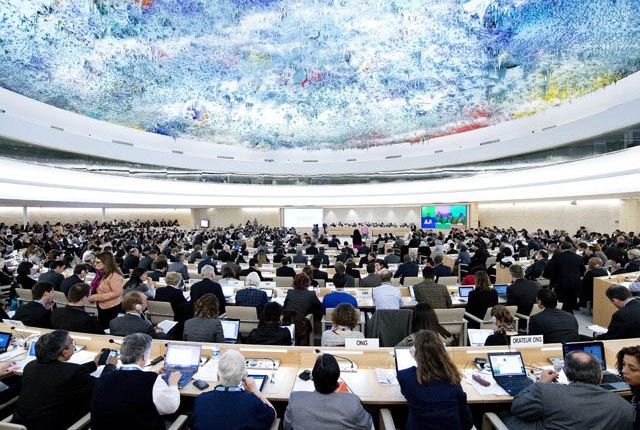Opinion | “All Human Beings are Born Free” By Feras, Gaza, Palestine
“All Human Beings are Born Free” reads the title of the Universal Declaration of Human Rights signed in Paris (France) on 10 Dec. 1948, voted for by 48 countries, with 8 abstentions but not a single country who voted against it.
The Declaration’s 30 articles include the right to dignity, liberty, equality, the right to life and political freedom, as well as the right to economic, social and healthcare rights. These are the rights that were ever since celebrated and elaborated in the subsequent international treaties, regional Human Rights instruments, national constitutions and trade deals. These were also the rights that finally resulted in the formulation of the International Bill of Human Rights, entered into force in 1976.

However, certain countries have concluded that the Declaration is not in and for itself part of domestic law. For example, in 2004, the Supreme Court of the United States on the case Sosa v. Alvarez-Machain concluded that the Declaration “does not of its own force impose obligations as a matter of international law”. Nevertheless, the Declaration has also served as the foundation for an increasing number of national laws, international laws and treaties, as well as for a growing number of regional, sub-national and national institutions concerned with the protection and promotion of Human Rights.
Thus, the question that emerges is: What is the extent and real application of this Declaration? and, when it comes to our region, how is the Declaration applied in terms of healthcare and medical rights? Through the following examples based on real-life stories, I will attempt to demonstrate the reality of the Declaration in practice.
First, there is the story of Ahmed. Ahmed is 27 years old and lives in Gaza which has a population of 2 million and whose inhabitants cannot leave if not via two exits: Rafah to Egypt, and Erez to Israel. More than 12 years of the blockade have passed since 2007, a blockade that has prevented Ahmed from leaving Gaza and has restricted the movement of goods and services coming in and from Gaza. This blockade means lack of medical equipment, supplies and health services. In 2016, Ahmed was diagnosed with cancer called Hodgkin’s Lymphoma and, although he was treated, he needed a scan to check for the recurrence of the tumour, a scan that was not available in Gaza. With Rafah’s closure, Ahmed had to apply to Israeli security services to exit Gaza and access the healthcare services in Israel. Every attempt of Ahmed to apply to exit Gaza has been unsuccessful. Ahmed waited for more than a year, a year in which he was continuously delayed or rejected. Many patients like Ahmed have faced this frustration, uncertainty and lack of transparency when it comes to permits to access healthcare outside Gaza. Moreover, those people receiving permits often end up being separated from their families and friends, sometimes for months. What should also be noted is that a referral to exit can have a high cost, meaning a loss of income and that patients and their relatives risk to being arrested and detained by Israeli forces to receive such care.
Then, there is the story of Abdullah, a 24-year old student from Gaza who was diagnosed with Non-Hodgkin Lymphoma in 2019. Abdullah received six cycles of chemotherapy at a hospital in Gaza City. After Abdullah’s initial treatment, doctors requested his referral to Augusta Victoria Hospital in East Jerusalem for further evaluation and investigation (including a PET scan unavailable in the Gaza Strip). Abdullah submitted a permit application for an appointment on the 10th of February 2020 during which his mother was supposed to accompany him. However, Abdullah’s permit application was delayed without approval by the date of his appointment. Abdullah was then requested to re-apply with a renewed medical report to be granted an appointment in April 2020. On this second occasion, the permit application was again denied. Abdullah now meets his doctor in Rantisi Hospital every three weeks, and he is supposed to re-apply and go, once again, through the same process in the face of uncertainty. Abdullah says: “I feel so stressed and I worry about my health. I hope to receive the PET scan so I can get the treatment I need. The scan can tell me if I’m clear and, then, I wouldn’t need more chemotherapy treatment”.
These real-life stories can draw several conclusions. On the one hand, the enjoyment of the highest attainable standard of health is one of the fundamental rights of every human being (with no distinction of race, religion, political belief, economic or social condition). On the other hand, Ahmed’s and Abdullah’s right to healthcare services in the Gaza Strip has not been protected. In addition, medical assistance outside Gaza is not granted. These are the stories of Ahmed and Abdullah, but they are not uncommon. In fact, since 2012, the percentage of patients whose exit from Gaza has been approved has dropped drastically: From more than nine in ten approved in 2012, to nearly half of applications being rejected in 2017. While such rate rose again in 2019 (with 60% of the applications being passed), it should be noted that 50% of companions (usually a relative) are denied of exit to accompany the patients. As a result, patients are expected to travel more than 70Km, access the hospital, undergo the procedure, and recover all in solitude. To conclude, Israel, the Palestinian Authority and the International Community who, according to the international law, have a duty to make sure these rights are fulfilled, are not doing enough.





Leave a Comment
Want to join the discussion? Feel free to contribute!